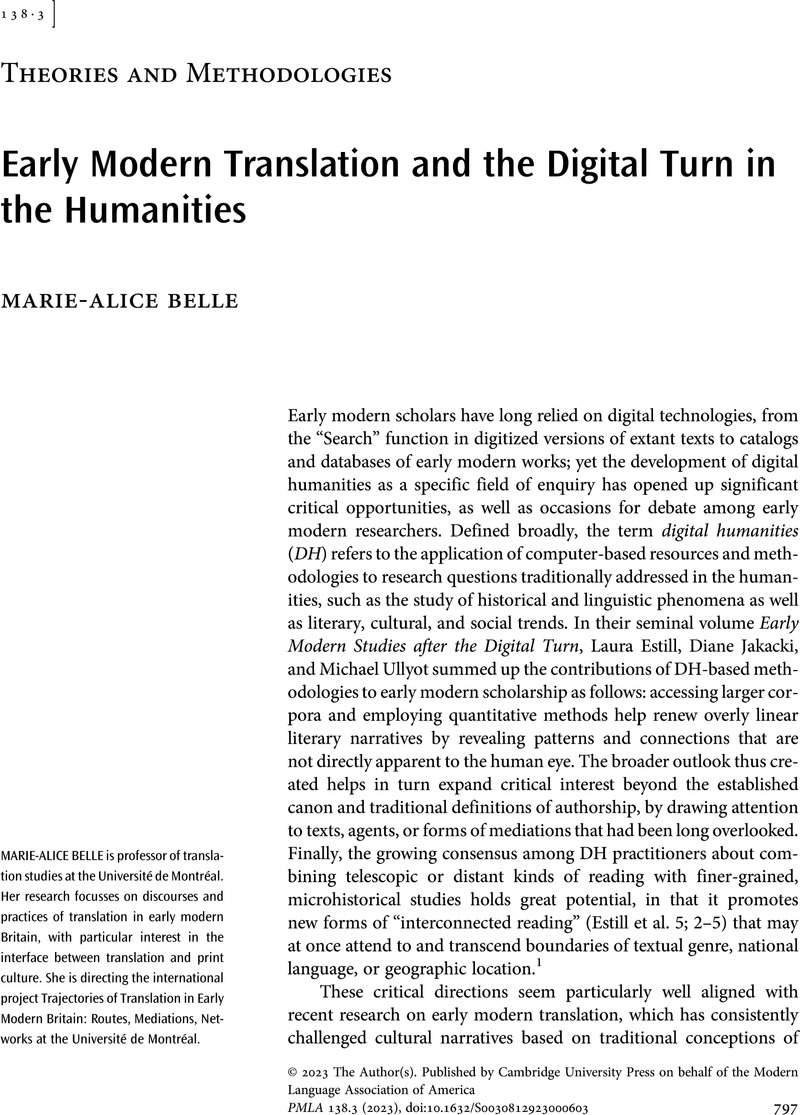No CrossRef data available.
Article contents
Early Modern Translation and the Digital Turn in the Humanities
Published online by Cambridge University Press: 12 September 2023
Abstract
An abstract is not available for this content so a preview has been provided. Please use the Get access link above for information on how to access this content.

- Type
- Theories and Methodologies
- Information
- Copyright
- Copyright © 2023 The Author(s). Published by Cambridge University Press on behalf of the Modern Language Association of America
References
Works Cited
Ahnert, Ruth, et al. The Network Turn: Changing Perspectives in the Humanities. Cambridge UP, 2021.Google Scholar
Armstrong, Guyda. “Towards a Spatial Early Modern Translation Studies.” inTRalinea: Online Translation Journal, vol. 21, 2019, pp. 1–10, www.intralinea.org/specials/article/towards_a_spatial_early_modern_translation_studies.Google Scholar
Baker, Mona. “Corpora in Translation Studies: An Overview and Some Suggestions for Future Research.” Target, vol. 7, no. 2, 1995, pp. 223–43.CrossRefGoogle Scholar
Belle, Marie-Alice, and Guénette, Marie-France. “Connected Identities: Representing Women in Seventeenth-Century English Translation and Print.” Translation in the Early Modern Period, edited by Bennett, Karen, Routledge, forthcoming.Google Scholar
Belle, Marie-Alice, and Guénette, Marie-France. “Translation and Print Networks in Seventeenth-Century Britain: From Catalogue Entries to Digital Visualizations.” New Technologies in Medieval and Renaissance Studies 3, edited by Davis, Matthew and Wilder, Colin F., U of Chicago P for Iter Press, 2022, pp. 195–233.Google Scholar
Booth, Alison. “Mid-Range Reading: Not a Manifesto.” PMLA, vol. 132, no. 3, May 2017, pp. 620–27.Google Scholar
Boutcher, Warren. “From Cultural Translation to Cultures of Translation?” The Culture of Translation in Early Modern England and France, 1500–1660, edited by Demetriou, Tania and Tomlinson, Rowan, Palgrave Macmillan, 2015, pp. 22–40.Google Scholar
Burke, Peter. “Cultures of Translation in Early Modern Europe.” Cultural Translation in Early Modern Europe, edited by Burke and Po-Chia Hsia, Ronnie, Cambridge UP, 2007, pp. 7–38.CrossRefGoogle Scholar
Chartier, Roger. Éditer et traduire: Mobilité et matérialité des textes (XVIe–XVIIIe siècle). Gallimard, 2021.Google Scholar
Coldiron, A. E. B. Printers without Borders: Translation and Textuality in the Renaissance. Cambridge UP, 2015.CrossRefGoogle Scholar
Coldiron, A. E. B. “The Translator's Visibility in Early Printed Portrait-Images and the Ambiguous Example of Margaret More Roper.” Thresholds of Translation: Paratexts, Print, and Cultural Exchange in Early Modern Britain (1473–1660), edited by Belle, Marie-Alice and Hosington, Brenda M., Palgrave Macmillan, 2018, pp. 51–74.CrossRefGoogle Scholar
Coldiron, A. E. B. “Visibility Now: Historicizing Foreign Presences in Translation.” Translation Studies, vol. 5, no. 2, 2012, pp. 189–200, https://doi.org/10.1080/14781700.2012.663602.CrossRefGoogle Scholar
Eder, Maciej. “A Bird's-Eye View of Early Modern Latin: Distant Reading, Network Analysis, and Style Variation.” Estill et al., pp. 61–88.Google Scholar
Estill, Laura, et al., editors. Early Modern Studies after the Digital Turn. Iter Press, 2016. New Technologies in Medieval and Renaissance Studies 6.Google Scholar
Hosington, Brenda M. “On Mediated Translation: A Fruitful Dialogue between Specialists in Translation Studies and Early Modern Translation.” Forum of Early Modern Studies, vol. 58, no. 4, Oct. 2022, pp. 478–87.CrossRefGoogle Scholar
Ladd, John R. “Imaginative Networks: Tracing Connections among Early Modern Book Dedications.” Journal of Cultural Analytics, vol. 6, no. 1, 2021, https://doi.org/10.22148/001c.21993.Google Scholar
McCarthy, Dennis. “Bloomfield, Lou, Project Creator. WCopyfind. Software.” Renaissance and Reformation / Renaissance et Réforme, vol. 44, no. 4, 2021, pp. 196–200, https://doi.org/10.33137/rr.v44i4.38646.CrossRefGoogle Scholar
McGann, Jerome. “The Rationale of Hypertext.” Electronic Text: Investigations in Method and Theory, edited by Sutherland, Kathryn, Oxford UP, 1997, pp. 219–46.Google Scholar
Rhodes, Neil. “Status Anxiety and English Renaissance Translation.” Renaissance Paratexts, edited by Smith, Helen and Wilson, Louise, Cambridge UP, 2013, pp. 107–20.Google Scholar
Siemens, Ray, et al. “Building A Social Edition of the Devonshire Manuscript.” Digital Scholarly Editing: Theories and Practices, edited by Driscoll, Matthew J. and Pierazzo, Elena, Open Book Publishers, 2016, pp. 137–60, books.openedition.org/obp/3409.CrossRefGoogle Scholar
Sinclair, Stéfan, and Rockwell, Geoffrey. “Text Analysis and Visualization: Making Meaning Count.” A New Companion to Digital Humanities, edited by Schreibman, Susan et al., Wiley-Blackwell, 2016, pp. 274–90.Google Scholar
Toury, Gideon. Descriptive Translation Studies and Beyond. John Benjamins, 1995.CrossRefGoogle Scholar
Tylus, Jane, and Newman, Karen, editors. Early Modern Cultures of Translation. U of Pennsylvania P, 2015.Google Scholar
van Vugt, Ingeborg. “Using Multi-layered Networks to Disclose Books in the Republic of Letters.” Journal of Historical Network Research, vol. 1, no. 1, 2017, pp. 25–51.Google Scholar
Venuti, Lawrence. The Translator's Invisibility. A History of Translation. Routledge, 1995.Google Scholar
Vickers, Brian. “Ingo Straub, creator. InfoRapid Search and Replace. Other.” Renaissance and Reformation / Renaissance et Réforme, vol. 44, no. 4, 2021, pp. 201–04, https://doi.org/10.33137/rr.v44i4.38647.CrossRefGoogle Scholar
Wakabayashi, Judy. “Digital Approaches to Translation History.” Translation and Interpreting, vol. 11, no. 2, 2019, pp. 132–45.CrossRefGoogle Scholar


